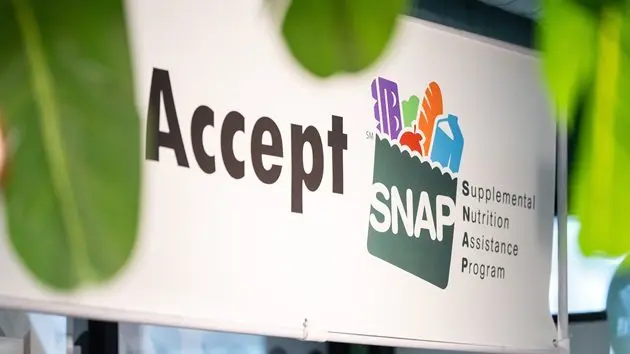With the introduction a few years back of the Food Pyramid by the USDA and its emphasis on eating more of a plant-based diet, Americans have begun to “rediscover” beans. Most people are familiar with the “grocery store” varieties such as pinto, navy, garbanzo (chickpeas), black and kidney, all of which are delicious and should be a part of every pantry in my view. They are highly nutritious and provide the basis for all kinds of inexpensive yet satisfying recipes. Beyond these familiar varieties however are a whole world of beans that many of us are completely unaware of. Today, thanks to the efforts of organizations like Seed Savers Exchange who are dedicated to preserving biological diversity, we are also being “reintroduced” to old heirloom varieties such as Scarlet Runner, Christmas Lima, Tongues of Fire, Appaloosa, Esther’s Swedish and other colorful and colorfully named beans.
The world of dried beans, which come in all manner of shapes and colors, is immense. One of humankind’s oldest cultivated crops; they have been around for at least 10,000 years. Beans were found in Egyptian tombs and are frequently referred to in the Bible. Beyond their worldwide use as food, beans (and legumes in general) have tremendous agricultural value. They are natural nitrogen producers and are critical in crop rotation programs whose goal is to renew the vigor of the soil. They are one of the key tools used in sustainable agriculture programs
Botanically, beans are the mature seeds from the enclosed pods of the large plant family known as Leguminose. Beans are only one part of the family however. Lentils, peas and even carob also belong. From a cook’s point of view, there are two bean types (excluding string beans): Fresh Shelling Beans: which are consumed fresh from their pods and Dried Beans which are dried to be consumed later. Fresh shelling beans are generally only available during a few weeks in summer. In addition to peas, the ones I usually look for are favas, which come to market in late spring; limas, cranberry and black-eyed peas that appear mid-to-late summer, and soybeans which come to market in summer and fall. All of these are also available dried but definitely look for them fresh. They offer a unique textural and flavor alternative to their dried counterparts and their great advantage is that they cook very quickly straight from the pod. Usually farm markets are the best places to find fresh shelling beans.
THE “QUICK SOAK” METHOD AND GAS!
In my cooking classes I find that the two reasons students give most often for not cooking and eating more dried beans are the long, overnight soaking time usually recommended and “GAS”! A few years ago the USDA came up with a technique that helps deal with both of these issues and it’s called The Quick Soak Method. It enables you to be ready to cook dried beans in an hour.
It’s very simple: First wash the dried beans thoroughly and pick through to remove any pebbles or other matter. (Remember dried beans are a natural agricultural product that comes to us right from the field, just like any other fruit or vegetable!). Place the washed beans in a deep saucepan and cover with at least 4 inches of cold water. Place the pan on the stove over high heat and bring it to a boil. As soon as the water boils, remove the pan from the heat and let it sit for at least one hour. What we’re looking for here is that the beans are plump with no wrinkled skins. Drain the beans and add fresh water and finish the cooking as described below.
Why does this work? The initial quick blanching releases a lot of the insoluble sugars, known as oligosaccharides, that are the main cause of gas, into the water. When you drained the beans and added new water, many of those sugars went right down the drain. The quick soak method then helps solve both of the reasons excuses for not cooking and eating more beans!
Many cooks believe that you can further “de-gas” beans by adding to the cooking water the herb Epazote (either fresh or dried) as they do in Mexico or a piece of the dried seaweed Kombu (available in Asian and natural foods stores) as the Japanese do. Both of these purportedly will further reduce those evil little gas-producing insoluble sugars! Some food scientists debunk this but I have to tell you that I’m a believer.
TO COOK THE BEANS:
Strain off this initial blanching water (again the beans should now be plump and fat), rinse the beans well, and return to the pan, again covering with 4 inches or so of cold water. Bring the beans to a boil and then reduce the heat so that they simmer gently, partially cover and cook until the beans are tender. This can take anywhere from 15 minutes to 2 hours or more depending on the variety and other factors which are discussed below.
My simple rules for cooking dried beans are these:
• Use the Quick Soak method described above. I prefer it to overnight soaking because sometimes, over the course of a long soak, the beans will ferment, causing off flavors.
• Never add salt or acidic ingredients such as tomatoes, citrus or wine to the beans until the beans have begun to soften. Although some beans are unaffected by these additions others are. Salt and acid can toughen the skins of some beans and result in uneven cooking. To be on the safe side, I add these seasonings near the end of the cooking time when the beans are almost done.
• If you are going to combine different beans in the same dish, cook each separately since, as I’ve noted, each variety will have a different cooking time. I’ve never been a fan of those 18 or 36 or however many dried bean mixtures that are sold even for soups.
• When you cook beans cook some extra and freeze for later use. Beans freeze well and that way you can have beans in short order.
• For bean salads, add vinaigrettes or other dressings while the beans are still warm, they will absorb the dressings better. If you’re starting with frozen or cooled beans, warm them first in the microwave or on the stovetop.
• Though beans varieties can generally be used interchangeably in any recipe, some are better for soups, some for salads, some for purees, because of their texture, flavor, or appearance. Experiment and develop your own favorites! You really can’t go wrong.
A FEW MORE TIPS ON COOKING BEANS:
Cooking time for beans will depend on several factors:
• How old the beans are. The previous year’s crop will take longer than this year’s. Unfortunately this is not always something you know when you purchase them.
• Quality of the cooking water. Beans take longer to cook in hard water.
• Altitude can also affect time. The higher you are the longer it’ll take.
• Variety difference. Some beans cook in as little as 15 minutes other can take 2 hours or more. Size of the bean is not a determinant of how long they’ll take to cook.
• Stove Top vs. Pressure Cooker. Using a pressure cooker can shorten cooking time by half or more.
Is it OK to use Canned Beans??
You bet it is. Canned beans can be used interchangeably in all of the following recipes and are perfectly acceptable. The only slight drawbacks that I find with canned is that they are sometimes overcooked and over salted. Drain and rinse them before using in any recipe.
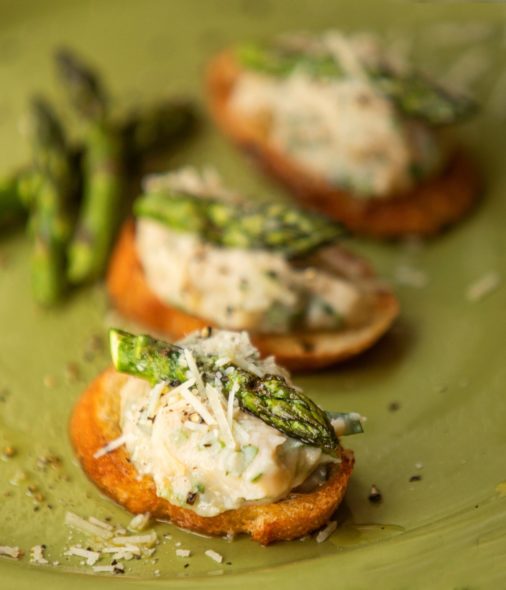
WHITE BEAN AND GRILLED ASPARAGUS CROSTINI
Makes 16 – 20 hors d’oeuvres
Good as an hors d’oeuvres I also like to use these as an addition to a salad of baby greens dressed with a citrus vinaigrette.
5 tablespoons olive oil
1 cup chopped onion
3 tablespoons chopped garlic
2 cups cooked and drained white beans such as cannellini, gigande or flageolet
2 tablespoons soy sauce
2 teaspoons finely grated lemon zest
3 tablespoons lemon juice
3 tablespoons chopped parsley
1 tablespoon chopped mint
Salt and freshly ground pepper
1/2-pound tender young asparagus
Lemon or truffle extra virgin olive oil
Toasted crostini to serve
Heat 3 tablespoons of olive oil in a sauté pan and add onions and garlic and sauté over moderate heat until vegetables just begin to color. Add the beans and heat through. Add mixture to a food processor along with soy sauce, lemon zest, lemon juice, parsley and mint and process in short bursts until fairly smooth (still should have a little texture). You may need to add a bit of broth or bean cooking liquid to facilitate. Season to taste with salt and pepper.
Lightly oil asparagus with remaining olive oil and season with salt and pepper. On an outdoor or stovetop grill pan, quickly grill asparagus until crisp-tender. Set aside.
To serve: Spread each crostini with a heaping tablespoon of the bean puree. Top with grilled asparagus cut to fit and drizzle each with a few drops of lemon olive oil.
JAMES BEARD’S BOSTON BAKED BEANS
Serves 6
The trick to good baked beans is cooking them very slowly with indirect heat. This recipe calls for baking them in a tightly sealed casserole in an oven barely hot enough to toast bread. As the hours pass, the beans drink up a broth flavored with brown sugar (or molasses), mustard and pepper. The gentle cooking prevents the beans from breaking up and becoming mushy. By the time they’re done, the pork is falling off its bones and the beans are the classic rusty brown. Be sure to season them amply with salt so the sweetness has a sturdy counterpart.
Beard’s recipe calls for dark brown sugar. The alternative is to use molasses, which will render a final flavor and color more familiar to canned-bean devotees. The recipe itself requires no great cooking skills — if you can peel an onion and boil water, you’re all set — but it will easily take up an afternoon. Plan it for a day when you’re at home.
2 cups of white pea beans (navy beans)
1 scant teaspoon salt, plus more to taste
1 medium onion, peeled
4 pork spareribs, or 8 baby-back ribs
1/3 cup dark brown sugar or molasses
2 teaspoons dry mustard
1 teaspoon ground black pepper
In a large bowl, soak the beans in 2 quarts of water for 6 hours. Drain the beans and put them in a large pot. Add the salt and enough cool water to cover 2 inches above the beans. Bring to a boil, then lower the heat and simmer gently, stirring occasionally, until the beans are just barely tender, 30 to 40 minutes. Drain well.
Bring another pot of water to a boil. Preheat the oven to 250 degrees. In the bottom of a large casserole with a tight-fitting lid, place the peeled onion — yes, whole — and spareribs (or baby-back ribs). Spread the beans on top. In a small bowl, mix together the brown sugar (or molasses), mustard and black pepper and add this to the beans and pork. Pour in just enough boiling water to cover the beans, put the lid on and bake, occasionally adding more boiling water to keep the beans covered, until they are tender but not falling apart, 4 to 5 hours.
Remove the casserole from the oven. Season the beans with salt. Pull the meat from the ribs. Discard the bones and excess fat and stir the meat back into the beans. With the lid off, return the casserole to the oven and let the beans finish cooking, uncovered and without additional water, until the sauce has thickened and is nicely caramelized on top, about 45 minutes more.
VEGETABLE CHILI WITH GARLIC RICE
Here you get two recipes for the price of one: a garlicky rice side dish that’s also delicious with chicken or shrimp and a hearty black-bean chili that rivals meat-based versions. Make enough chili for leftovers; it’s even better the next day.
3 tablespoon(s) cooking oil
1 medium onion, chopped
5 cloves garlic, minced
1 tablespoon pure chili powder such as ancho
2 teaspoons ground cumin
1/2teaspoon cayenne
2 small red or green bell peppers, cut into 3/4-inch squares
1 zucchini, cut into 3/4-inch dice
1 yellow squash, cut into 3/4-inch dice
1 1/2teaspoons salt or to taste
2 cans (15 ounces each) diced tomatoes with their juice
1can (15-ounce) black or pinto beans, drained and rinsed
1 1/2 cups long-grain white rice
3 cups canned chicken broth or homemade stock
3 tablespoons chopped cilantro
In a large saucepan, heat 2 tablespoons of the oil over moderately low heat. Add the onion and cook, stirring occasionally, until translucent, about 5 minutes. Stir in one third of the garlic, the chili powder, cumin, and cayenne and cook until fragrant, stirring, about 1 minute. Add the bell peppers, zucchini, yellow squash and 1 teaspoon of the salt. Cook, stirring occasionally, until the vegetables start to soften, about 5 minutes.
Add the tomatoes and simmer, stirring occasionally, for 20 minutes. Stir in the beans and simmer until the vegetables are tender, about 5 minutes longer.
Meanwhile, in a medium saucepan, heat the remaining tablespoon of oil over moderately low heat. Add the remaining garlic and the rice. Cook, stirring, until the rice is almost opaque, about 2 minutes. Add the broth and the remaining 1/2 teaspoon of salt and bring to a simmer. Reduce the heat to low and cook, covered, until the rice is tender, about 20 minutes.
Stir the cilantro into the chili and serve atop the rice.
ITALIAN MARROW BEANS WITH TUNA
Serves 4
Cannellini, flageolet or any other mild white bean will work here.
One 5-ounce can best-quality, olive oil–packed tuna, drained slightly
1/2 medium sweet onion, very thinly sliced
1 celery stalk, cut in half lengthwise and then on the diagonal into 1/4-inch-thick slices
1/3 cup chopped fresh flat-leaf parsley
2 1/2 cups well-drained, cooked marrow beans, warmed slightly
3 tablespoons extra-virgin olive oil
2 teaspoons red wine vinegar
Salt and freshly ground pepper
Place the tuna in a salad bowl and break it up slightly with a fork. Add the onion, celery, parsley, and beans. Drizzle with olive oil and vinegar. Season with salt and pepper and toss well. Taste and adjust seasonings. Serve at room temperature within 2 hours.
GARBANZO AND HERB SALAD WITH POMEGRANATE DRESSING
Serves 4
This is my version of a simple salad that I had years ago in Greece as part of a mezze or antipasto offering. You could use any fleshy bean that you liked such as lima or flageolet in place of the garbanzo. When fresh pomegranates are available in the fall, I add some of their jewel-like seeds as garnish.
2 cups cooked garbanzo beans
1-1/2 cups lightly packed torn or coarsely chopped Italian parsley leaves
1/3 cups lightly packed torn or coarsely chopped mint leaves
1 small red onion, thinly sliced and soaked in ice water
1 medium English or Armenian cucumber halved, peeled, seeded and sliced at an angle
Pomegranate dressing (recipe follows)
4 ounces drained feta, crumbled
Freshly ground black pepper
Combine the beans, herbs, drained onion and cucumber and toss lightly with the dressing. Mound on plates and scatter feta over top along with a few grinding of pepper.
Pomegranate Dressing
4 tablespoons extra virgin olive oil
2 tablespoons fresh lemon juice
2 tablespoons pomegranate molasses (available at Gourmet and Middle Eastern stores)
Salt and freshly ground pepper to taste
Whisk all ingredients together and adjust seasoning to your taste.
GIANT WHITE BEAN STEW
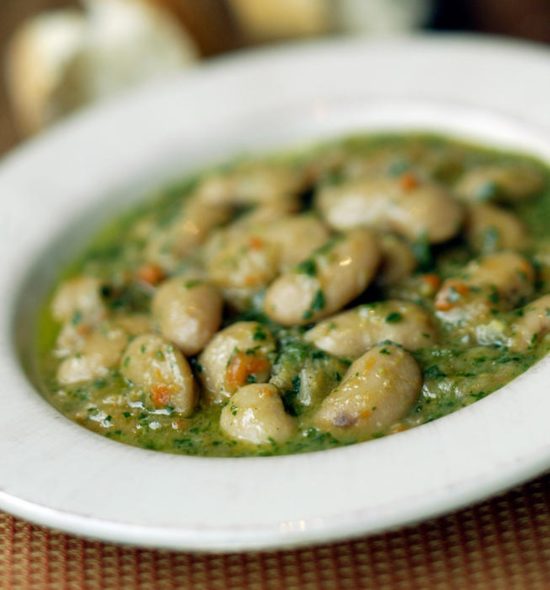
Soup
1-pound dried Gigandes or Italian Corona beans
Bouquet garni
6 cloves garlic, peeled
1 large onion
1 large carrot
1/2 leek
Olive oil
Sea salt and freshly ground black pepper to taste
Place the beans in a bowl and cover by 3 inches with cold water. Soak for 12 to 14 hours. Drain. Place the beans in a heavy-bottomed pot and cover by 2 inches with water. Add the bouquet garni and garlic, and bring to boil, reduce the heat and simmer until the beans are tender, 1 to 1 1/2 hours. Toward the end of cooking, finely chop the onion, carrot and leek. Heat 2 tablespoons of oil in a skillet over medium heat. Add the vegetables and cook until the onions turn golden, 5 minutes.
Remove the bouquet garni, add the onion, carrot and leek. Simmer until the beans are very tender, about 30 minutes. Season well with salt and pepper.
Drain off 2 cups of the cooking liquid and reduce in a saucepan over medium heat until it reaches a medium-thick consistency, about 7 minutes. Return the liquid to the beans, toss and add the parsley sauce. Toss and serve immediately.
Parsley sauce
• 4 cups Italian parsley leaves
• 1/2 cup (1 stick) butter, melted
• 2 cloves garlic
Combine the parsley, butter and garlic in a food processor and pulse until finely chopped, about 15 seconds.
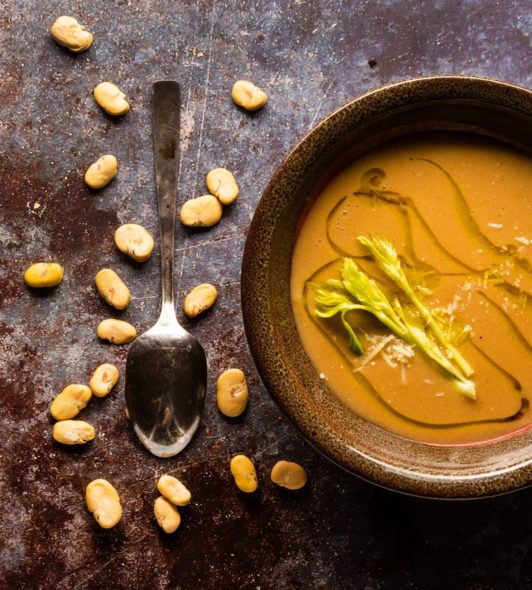
HABA BEAN SOUP
Makes a generous 8 cups serving 6 – 8
Haba beans are peeled (saves lots of hand work) and dried fava beans and are nutritional powerhouses. You can find them at Mexican and Middle Eastern markets or on-line. I get mine from Purcell Mountain Farms www.purcellmountainfarms.com
6 tablespoons extra virgin olive oil
2 cups (2 small) finely chopped onions
2 tablespoons finely chopped garlic
1 cup chopped celery or fennel
1 tablespoon ground cumin
1 teaspoon crushed fennel seed
1/4 teaspoon red chile flakes
2 cups dried haba beans, rinsed and soaked for 4 hours or more and drained
6 cups tasty chicken or vegetable stock
Salt and freshly ground pepper
1 – 2 tablespoons dried sumac powder or 2 tablespoons fresh lemon juice
Freshly grated aged goat cheese or parmesan and celery leaves to garnish
Heat 3 tablespoons oil in a deep soup pot and add the onions, garlic and celery and sauté over moderate heat until crisp tender. Add the cumin, fennel seed and chile flakes and continue to sauté for 2 – 3 minutes until spices become fragrant.
Add the soaked habas and stock and bring to a boil. Lower heat to a simmer, cover and cook for 25 – 30 minutes or until beans are very tender and falling apart. Cool slightly and puree mixture with an immersion or regular blender. (If using the latter be careful since hot liquids expand mightily. Fill blender jar only half full, use lowest speed and cover top with a clean towel rather than the lid to allow for expansion.) Season to your taste with salt and pepper.
To serve: Sprinkle sumac on top of soup or alternately stir in fresh lemon juice into each serving. Drizzle remaining olive oil around and finish with a grating of cheese and celery leaves, if using.
MEXICAN BLACK BEAN SOUP
Serves 6 – 8
This is a soup based on a recipe from a home cook friend in the Yucatan. Like most soups in that area the role of the garnishes is very important and you can use any or all of those suggested.
1-pound black beans
6 cups water
4 cups rich chicken stock
1/4 cup olive oil
2 medium white onions chopped
6 cloves garlic, chopped
1 teaspoon cumin powder
1/2 teaspoon fennel seeds
1 tablespoon oregano leaves, preferably Mexican
2 teaspoons medium hot chile powder such as Ancho or Chimayo powder, or to taste
Kosher or sea salt and freshly ground black pepper
1-1/2 cups cooked rice, optional
Garnishes (any or all!):
Chopped green onions, including tops
Cilantro sprigs
Diced avocado
Diced fresh tomato
Sliced radishes
Thinly sliced fried corn tortillas
Lime wedges
Crema or sour cream
Chopped jalapeno or serrano chilies
Pick over the dry beans and rinse. Place beans and water in a soup pot; cover and simmer for about 30 minutes. Add chicken stock and simmer till beans are tender, about 1 hour total. Dip out about 2 cups of bean mixture and carefully puree in a blender or food processor. Add back to pot.
Heat the oil in a skillet over moderately high heat and sauté the onion, garlic, cumin, fennel, oregano and chile until the onions are soft. Add to the soup pot along with the rice if using and simmer for a few minutes more. Serve with garnishes to be added as desired.
MASH OF FAVA BEANS, POTATOES, GREENS AND POACHED EGGS
Serves 6
From Apulia this is a classic supper dish. You’ll need peeled dried fava beans for this recipe which are available at Italian and Middle Eastern markets as well at from Purcell Mountain Farms. They are also known as Haba Beans.
8 ounces dried, peeled fava beans
3 cups water
3 cups chicken or vegetable stock
2 medium Yukon gold potatoes, about 1 pound, peeled and cut into 1-inch cubes
1/2 pounds tender arugula
4 tablespoons flavorful extra virgin olive oil plus extra for drizzling
Sea Salt and freshly ground black pepper
2/3 cup freshly grated Parmesan, Asiago or Pecorino cheese
6 large poached or fried eggs
Place the dried favas in a large saucepan, add water and stock and bring to a boil. Reduce heat and simmer for 10 minutes. Add the potatoes and simmer until the favas and potatoes are tender and falling apart, about 20 minutes. If the pot starts to run dry before the beans and potatoes are done, add a little more water. The mixture should be fairly dry when done. If not stir over moderate heat to evaporate any remaining moisture.
Meanwhile chop the arugula and sauté until softened in 2 tablespoons of olive oil. Season to taste with salt and pepper and set aside.
Mash the potatoes and favas and beat for a minute or two until they are fluffy. Beat in the remaining olive oil, parmesan and the cooked greens and season to your taste with salt and pepper.
Divide the puree among 6 bowls, top with an egg and drizzle with more olive oil if desired.
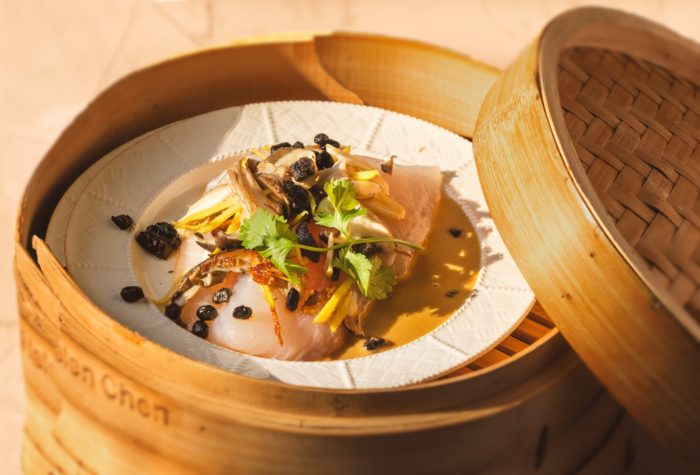
SEA BASS STEAMED WITH BLACK BEANS
Serves 4
Steaming is a wonderful, healthy way to cook fish. The Chinese are masters at this technique. Here I’ve used Sea Bass but you could use any firm white fish or even salmon, scallops or shrimp adjusting cooking times accordingly. I usually use a Chinese bamboo steamer set over a pot of boiling water. The advantage of these is that you can stack several on top of each other so that you can easily double the recipe. If you don’t have a bamboo steamer you can jury-rig your own with any deep pot that has a tight-fitting cover and that is wide enough to hold the steaming plate. Simply place an ovenproof ramekin on the bottom of the pot to elevate the plate above the boiling water. Fermented or salted black beans are widely available in Asian markets and some super markets.
For the Sauce:
2 tablespoons soy sauce or tamari
2 tablespoons dry sherry or Shao-Hsing wine
1 tablespoon brown sugar
1 tablespoons rice vinegar
1 tablespoon fresh lemon juice
1 tablespoon toasted sesame oil
Pinch freshly ground white pepper
3 tablespoons chicken or vegetable stock
6 tablespoons olive oil
1 tablespoon finely sliced garlic
1-1/4 cups sliced shiitake mushrooms, stems removed and discarded
1 tablespoon peeled and very finely slivered fresh ginger
4 six-ounce Sea Bass fillets
3 tablespoons Chinese dried (fermented) black beans, rinsed well
Garnish: fresh cilantro sprigs
In a blender add the soy sauce, sherry, sugar, vinegar, lemon juice, sesame oil, pepper and stock and blend for a few seconds. With motor running add 4 tablespoons oil slowly to form a lightly thickened sauce. Set aside.
In a sauté pan add the remaining oil over moderately high heat and quickly sauté the garlic, mushrooms and ginger until just cooked through. Place the fish on a heatproof plate (or plates) that will fit in your steamer. Top each with some of the mushroom mixture and then spoon sauce mixture over that. Sprinkle black beans around and carefully put plate(s) in the steamer. Cover and steam until the fish is just cooked through, about 10 minutes.
Place fish on warm serving plates and spoon juice and vegetables over. Garnish with cilantro sprigs and serve immediately.
BLACK BEAN VEGGIE BURGER
Serves 4
The repeated chorus with all burgers is to not over work them when putting them together to make sure that they have some texture and moisture left in them after cooking. This is also important with vegetable-based burgers. You can grill or sauté these but I prefer the latter because they are more delicate and have a bit of a tendency to fall apart since they don’t have the raw protein that meats and fishes have to hold everything together. If you decide to grill them, I recommend a hinged grill rack, which makes it easy to turn them. This recipe has a bit of a Mexican twist to it.
3 tablespoons olive oil
1/2 cup chopped green onions, including both white and green parts
1 small seeded and stemmed poblano pepper, finely chopped (about 1/2 cup)
2 large cloves garlic, finely chopped
1 15 oz. can cooked black beans, drained and rinsed
1/2 cup roughly chopped and loosely packed cilantro leaves
1 large egg, lightly beaten
1/2 cup toasted whole grain breadcrumbs, made from 2 slices or so of bread
1/2 teaspoon pure chile powder such as Ancho or Chimayo
1/4 teaspoon ground cumin
1/2 teaspoon salt or to taste
Heat 1 tablespoon oil in a small sauté pan over moderate heat and add the onions, pepper and garlic and sauté for a minute or two to just soften a little and remove the raw taste. Remove from heat and place in the bowl of a food processor along with the beans. Pulse 2 or 3 times to roughly chop the beans. Be very careful not to over process.
Place mixture in a bowl and gently stir in the rest of ingredients. Divide the mixture into 4 portions and form into patties. Chill uncovered for at least 30 minutes in the refrigerator. Add the remaining 2 tablespoons oil to a sauté pan and over medium heat cook the burgers until nicely browned on both sides, about 5 minutes.
Serve on a bun with traditional garnishes or, to complete the Mexican theme, top with some of the following salsa:
Tomatillo and Avocado Salsa
Makes about 3/4 cup
1 medium fresh tomatillo, husk removed, washed and coarsely chopped
1/2 teaspoon chopped garlic
1/2 teaspoon seeded and chopped fresh serrano chile, or to taste
1 tablespoon chopped green onion
1 large ripe avocado, peeled and pitted
Salt and freshly ground pepper to taste
In a food processor add the tomatillos, garlic, chile and scallions and pulse to finely chop. Coarsely chop the avocado, add to the processor and pulse until just blended. Salsa should still have some texture. Season to taste with salt and pepper. Store covered and refrigerated for up to 2 days.

WHITE BEANS WITH ‘NDUJA, KALE, AND BREADCRUMBS
Serves 4
‘Nduja is a spicy, spreadable fermented pork salami that originated in the southern Italian region of Calabria. Most cured sausages have a three-to-one lean-meat-to-fat ratio, but ‘nduja flips that ratio and boasts a three-to-one fat-to-meat ratio. This high fat content gives ‘nduja its soft, spreadable texture and allows it to easily emulsify and meld into sauces, stews, and the like. ‘Nduja also brings plenty of floral heat from crushed Calabrian chilies, which comprise 30% of the sausage mixture. It is lightly smoked and fermented, which gives the sausage a deep flavor with a nice funky finish. Look for it in markets that specialize in Italian charcuteries or on-line.
For the Beans:
3 tablespoons extra-virgin olive oil
large shallots, thinly sliced
2 garlic cloves, peeled and thinly sliced
Kosher salt
4 ounces (1/2 cup) ‘nduja
3 (15-ounce) cans low-sodium white beans such as cannellini or Great Northern, drained and rinsed
3 cups homemade or store-bought low-sodium chicken stock
1 small bunch (2 – 3 ounces) lacinato kale, tough stems removed, leaves cut into 1-inch pieces
1 tablespoon fresh lemon juice (from one lemon; zest finely grated and set aside before juicing fruit)
For the Breadcrumb topping:
2 tablespoons extra-virgin olive oil
1/2 cup (1 1/4 ounces) panko breadcrumbs
1/4 cup chopped fresh flat-leaf parsley leaves
Finely grated zest from one lemon
For the Beans:
In large, straight-sided sauté pan or Dutch oven, heat olive oil over medium heat until shimmering. Add shallots and garlic, season lightly with salt, and cook, stirring frequently, until softened but not brown, 5 to 7 minutes.
Add ‘nduja and, using a wooden spoon, break it into pieces and stir vigorously to combine with shallots and garlic. Continue to cook, stirring frequently, until fat from ‘nduja separates, and shallots and garlic are stained red and fully coated with ‘nduja, 3 to 5 minutes longer.
Add beans. Use wooden spoon to crush roughly 1/4 of the beans against sides and bottom of the pan. Stir until beans are fully incorporated and coated in ‘nduja-shallot mixture.
Add chicken stock, season lightly with salt, and bring to a simmer. Cook, stirring occasionally, until thickened to a creamy, stew-like consistency, with some beans just poking out on the surface, about 15 minutes.
Add kale and stir to incorporate and very lightly wilt the greens, about 30 seconds. Remove from heat, stir in lemon juice, and season to taste with salt.
For the Breadcrumbs: While the beans simmer, combine oil and breadcrumbs in medium skillet, and cook over medium-low heat, stirring occasionally, until toasted and golden brown, 5 to 7 minutes. Add parsley and lemon zest, season lightly with salt, stir to combine, and continue to cook until parsley begins to sizzle and mixture is very fragrant of citrus, 30 seconds to 1 minute. Transfer breadcrumb mixture to a small bowl and set aside until you are ready to serve.
For Serving: Divide beans between individual serving bowls and sprinkle with breadcrumbs. Serve immediately, passing more breadcrumbs at the table.
All Photos by John Burgess of the Santa Rosa Press Democrat
John Ash © 12/23


